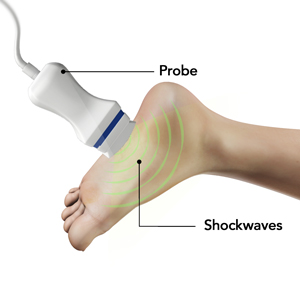Shockwave Therapy

Extracorporeal Shock Wave Therapy (ESWT) is a non-invasive (no cutting of skin and no introduction of any medical device in the body) method of treating soft tissue injuries. Extracorporeal means outside the body. Shock wave is a short energy wave with high intensity, traveling faster than sound. ESWT does not disintegrate tissue; rather it causes biological effects that help in tissue regeneration. ESWT reduces pain and sensitivity immediately by over-stimulating pain transmission nerves. It triggers the repair mechanism of the body by formation of new blood vessels. The shock wave stimulates osteoblasts (bone cells) in the body and promotes bone healing and new bone production.
Indications for Shockwave Therapy
ESWT is used to treat many musculoskeletal conditions such as attachment points for ligaments and bones. A very common indication for ESWT is heel spurs. Some of the other indications include tennis elbow, golfer’s elbow, jumper’s knee, shoulder injury, Achilles tendon injury, connective tissue pain and degeneration, muscle pain and injuries. ESWT is also used for bone healing conditions like stress fractures, avascular necrosis (dead portion of bone), non-healing bone or slow healing bone. Peyronie’s disease, a urological condition is also treated by ESWT.
Pre-treatment Care for Shockwave Therapy
The ESWT treatment course involves two outpatient sessions. The duration between the sessions is 1 week. You should not consume heavy meals before the session and you will be asked to wear loose fitting clothes.
Treatment Schedule for Shockwave Therapy
During the session, you will be seated comfortably on a table. A scanner will be used to guide the shock wave emitter exactly to the site of injury. Around 2000 shock waves will be fired and a tapping sensation will be followed with each shock wave. Duration of each session is about 30 minutes.
Post-treatment Care for Shockwave Therapy
You can continue with your regular daily activities immediately after each session. In cases of heel spurs, running should be avoided for a week or more after the second session of ESWT.
Risks and Complications of Shockwave Therapy
ESWT has no major risks. The most commonly observed minor risks are –
- Pain (energy levels of shock waves can be adjusted to individual’s tolerance levels)
- ESWT is not preferred if you have bone tumors, metabolic bone conditions and nerve or circulation disorders.
- It is not recommended for pregnant women, areas of infection, locations where gas is present in the body and on locations where bone is still growing.
- ESWT is considered a safe and effective treatment option for soft tissue injuries.




